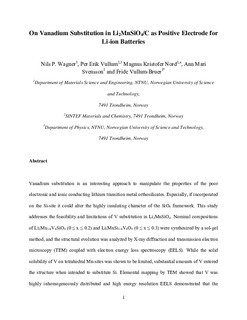| dc.contributor.author | Wagner, Nils Peter | |
| dc.contributor.author | Svensson, Ann Mari | |
| dc.contributor.author | Vullum-Bruer, Fride | |
| dc.date.accessioned | 2017-10-30T13:12:07Z | |
| dc.date.available | 2017-10-30T13:12:07Z | |
| dc.date.created | 2016-05-20T12:52:20Z | |
| dc.date.issued | 2016 | |
| dc.identifier.citation | Electrochimica Acta. 2016, 203 246-256. | nb_NO |
| dc.identifier.issn | 0013-4686 | |
| dc.identifier.uri | http://hdl.handle.net/11250/2462902 | |
| dc.description.abstract | Li2MSiO4 (M = Fe, Mn, Co) compounds have since their discovery gained increased attention as alternative, inexpensive and inherently safe positive electrodes for Li-ion batteries. To meet the required performance for an electrode, sophisticated, complex and time-consuming synthesis measures are required at present. Here, we present a time-efficient and scalable aerosol combustion method with subsequent annealing, leading to nanoscale and carbon-coated Li2FeSiO4 and Li2Fe0.5Mn0.5SiO4. Using liquid-feed flame spray pyrolysis, we demonstrate synthesis of orthosilicate materials, with phase purities exceeding 95 wt. % according to Rietveld quantifications, in a relatively short time. The importance of the precursor concentration, in order to obtain loosely agglomerated nanoparticles, is discussed and the long-term performance is investigated. In the case of Li2FeSiO4, the optimised precursor concentration yielded particles of about 30 nm, which delivered an initial discharge capacity of up to 150 mAhg−1 at 60 °C and C/20. Furthermore, over 50% of the capacity is retained at a high rate of 5C, and long-term cycling showed outstanding capacity retention of over 90% after 300 cycles at a moderate rate of C/2. Li2Fe0.5Mn0.5SiO4 on the other hand, was shown to suffer from a severe capacity fade, and upon prolonged cycling the redox activity can be attributed solely to Fe. | nb_NO |
| dc.language.iso | eng | nb_NO |
| dc.publisher | Elsevier | nb_NO |
| dc.rights | Attribution-NonCommercial-NoDerivatives 4.0 Internasjonal | * |
| dc.rights.uri | http://creativecommons.org/licenses/by-nc-nd/4.0/deed.no | * |
| dc.title | Flame-made Lithium Transition Metal Orthosilicates | nb_NO |
| dc.type | Journal article | nb_NO |
| dc.type | Peer reviewed | nb_NO |
| dc.description.version | acceptedVersion | nb_NO |
| dc.source.pagenumber | 246-256 | nb_NO |
| dc.source.volume | 203 | nb_NO |
| dc.source.journal | Electrochimica Acta | nb_NO |
| dc.identifier.doi | 10.1016/j.electacta.2016.04.052 | |
| dc.identifier.cristin | 1356538 | |
| dc.relation.project | Norges forskningsråd: 216469 | nb_NO |
| dc.description.localcode | This is the authors' accepted and refereed manuscript to the article. Locked until 12 April 2018 due to copyright restrictions. | nb_NO |
| cristin.unitcode | 194,66,35,0 | |
| cristin.unitname | Institutt for materialteknologi | |
| cristin.ispublished | true | |
| cristin.fulltext | postprint | |
| cristin.qualitycode | 2 | |

